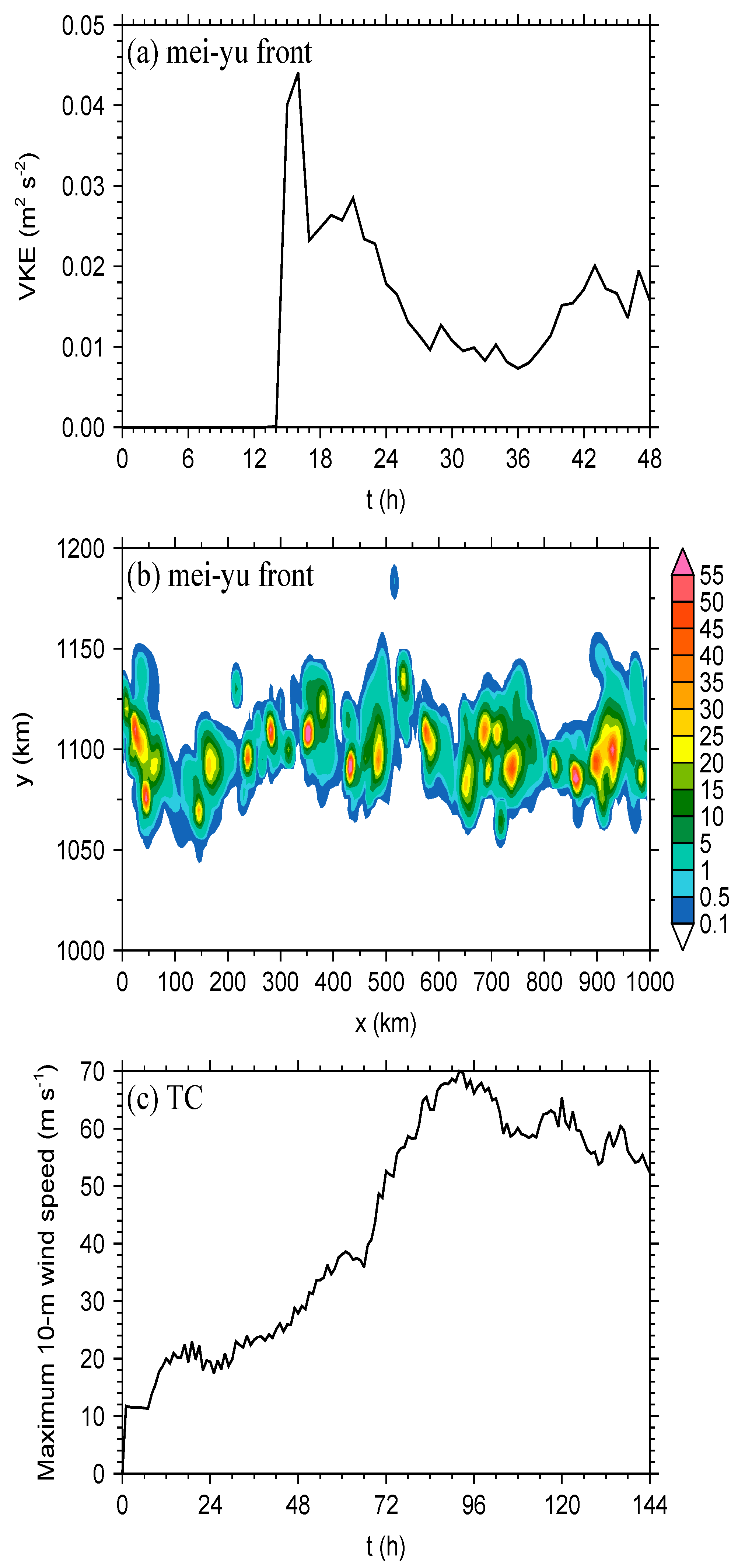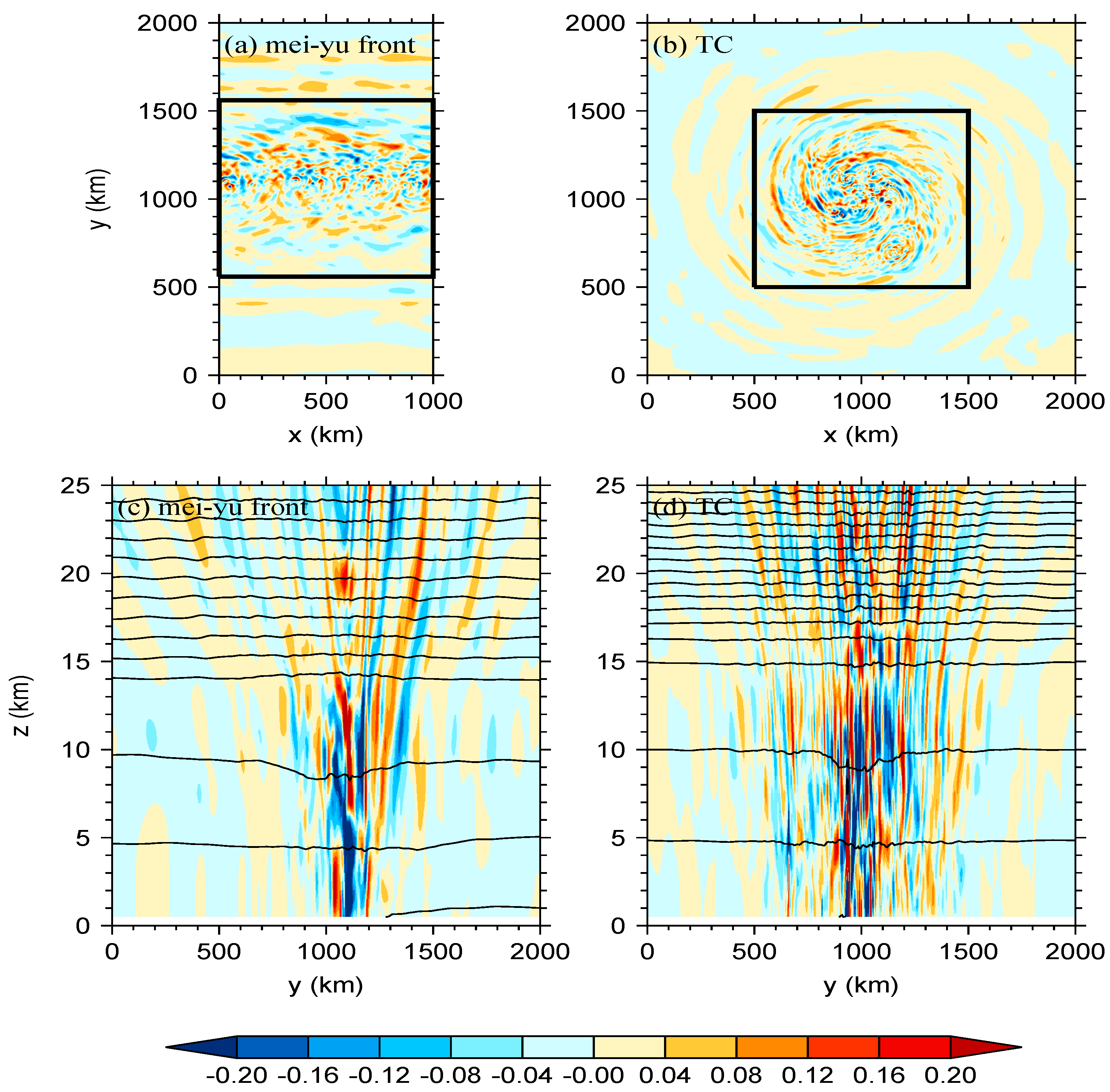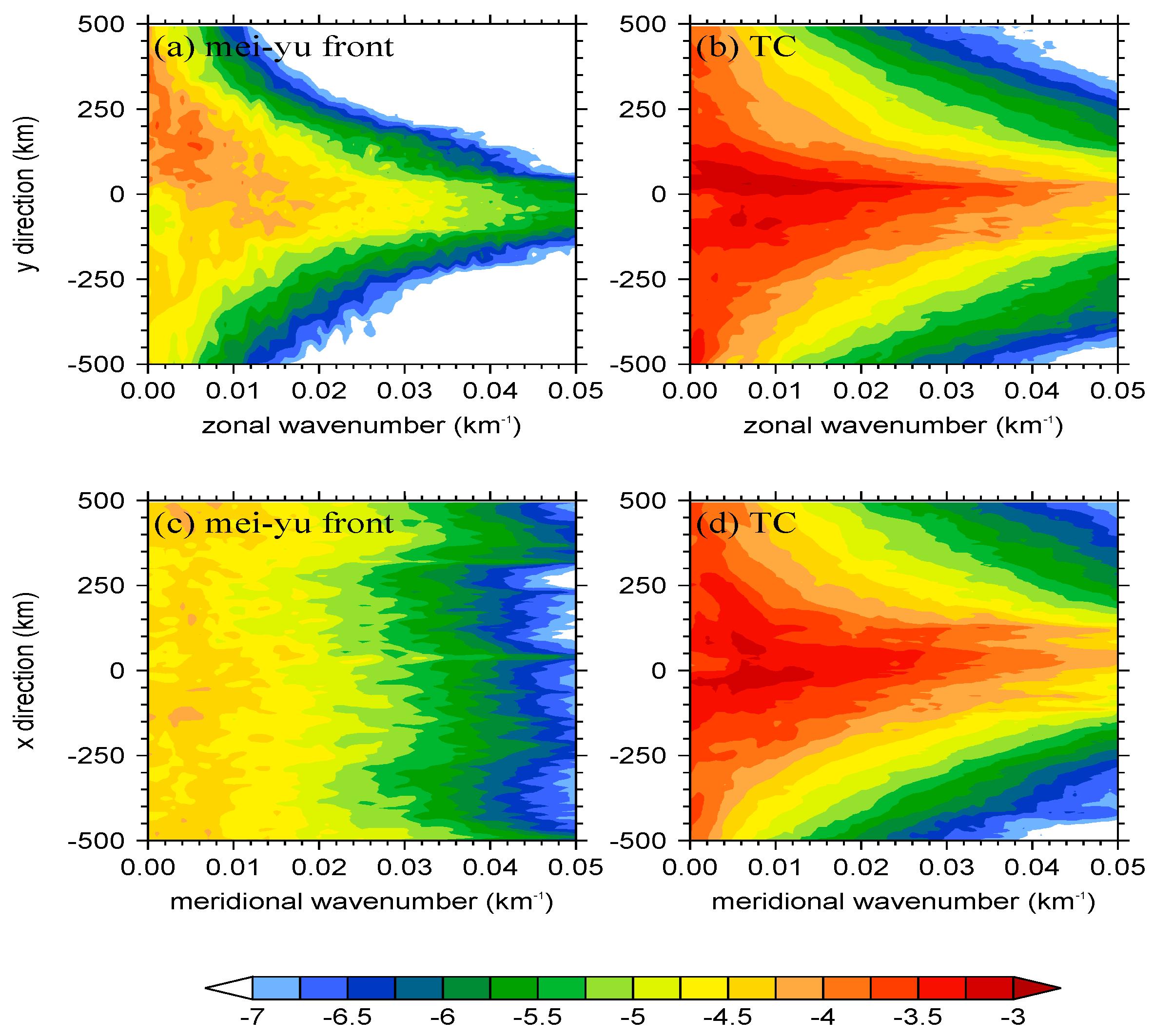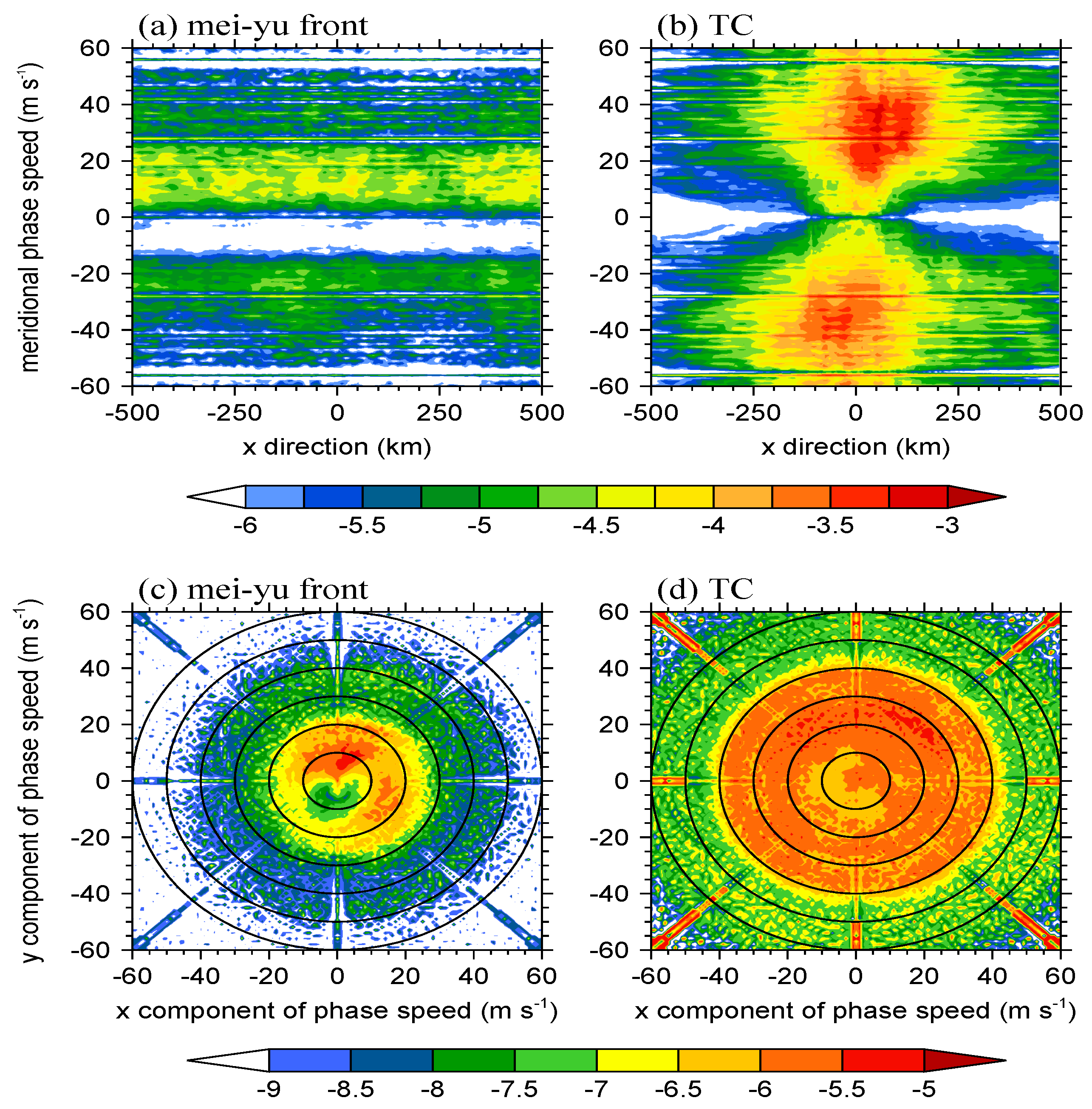On the Spectra of Gravity Waves Generated by Two Typical Convective Systems
Abstract
1. Introduction
2. Experimental Design
3. Results
3.1. Overview of the Simulations
3.2. Spectral Analysis of the Lower-Stratospheric Gravity Waves
4. Conclusions
Author Contributions
Funding
Conflicts of Interest
References
- Xu, X.; Shu, S.; Wang, Y. Another look on the structure of mountain waves: A spectral perspective. Atmos. Res. 2017, 191, 156–163. [Google Scholar] [CrossRef]
- Dörnbrack, A.; Gisinger, S.; Kaifler, N.; Portele, T.C.; Bramberger, M.; Rapp, M.; Gerding, M.; Söder, J.; Žagar, N.; Jelić, D. Gravity waves excited during a minor sudden stratospheric warming. Atmos. Chem. Phys. 2018, 18, 12915–12931. [Google Scholar] [CrossRef]
- Podglajen, A.; Plougonven, R.; Hertzog, A.; Jensen, E. Impact of gravity waves on the motion and distribution of atmospheric ice particles. Atmos. Chem. Phys. 2018, 18, 10799–10823. [Google Scholar] [CrossRef]
- Shapiro, M.A. Turbulent mixing within tropopause folds as a mechanism for the exchange of chemical constituents between the stratosphere and troposphere. J. Atmos. Sci. 1980, 37, 994–1004. [Google Scholar] [CrossRef]
- Lane, T.P.; Zhang, F. Coupling between gravity waves and tropical convection at mesoscales. J. Atmos. Sci. 2011, 68, 2582–2598. [Google Scholar] [CrossRef]
- Holton, J.R.; Haynes, P.H.; McIntyre, M.E.; Douglass, A.R.; Road, R.B.; Pfister, L. Stratosphere–troposphere exchange. Rev. Geophys. 1995, 33, 403–439. [Google Scholar] [CrossRef]
- Fritts, D.C.; Alexander, M.J. Gravity wave dynamics and effects in the middle atmosphere. Rev. Geophys. 2003, 41, 1003. [Google Scholar] [CrossRef]
- Kim, Y.-J.; Eckermann, S.D.; Chun, H.-Y. An overview of the past, present and future of gravity-wave drag parametrization for numerical climate and weather prediction models. Atmos. Ocean 2003, 41, 65–98. [Google Scholar]
- Alexander, M.J.; Beres, J.H.; Pfister, L. Tropical stratospheric gravity wave activity and relationships to clouds. J. Geophys. Res. 2000, 105, 22299–22309. [Google Scholar] [CrossRef]
- Halliday, O.H.; Griffiths, S.D.; Parker, D.J.; Stirling, A.; Vosper, S. Forced gravity waves and the tropospheric response to convection. Q. J. R. Meteorol. Soc. 2018, 144, 917–933. [Google Scholar] [CrossRef]
- Baik, J.-J.; Hwang, H.-S.; Chun, H.-Y. Transient, linear dynamics of a stably stratified shear flow with thermal forcing and a critical level. J. Atmos. Sci. 1999, 56, 483–499. [Google Scholar] [CrossRef]
- Alexander, M.J.; Vincent, R.A. Gravity waves in the tropical lower stratosphere: A model study of seasonal and interannual variability. J. Geophys. Res. 2000, 105, 17983–17993. [Google Scholar] [CrossRef]
- Lane, T.P.; Reeder, M.J.; Clark, T.L. Numerical modeling of gravity wave generation by deep tropical convection. J. Atmos. Sci. 2001, 58, 1249–1274. [Google Scholar] [CrossRef]
- Beres, J.H.; Alexander, M.J.; Holton, J.R. Effects of tropospheric wind shear on the spectrum of convectively generated gravity waves. J. Atmos. Sci. 2002, 59, 1805–1824. [Google Scholar] [CrossRef]
- Wei, J.; Zhang, F.; Richter, J.H. An analysis of gravity wave spectral characteristics in moist baroclinic jet-front systems. J. Atmos. Sci. 2016, 73, 3133–3155. [Google Scholar] [CrossRef]
- Pfister, L.; Chan, K.R.; Bui, T.P.; Bowen, S.; Legg, M.; Gary, B.; Kelly, K.; Proffitt, M.; Starr, W. Gravity waves generated by a tropical cyclone during the STEP tropical field program: A case study. J. Geophys. Res. 1993, 98, 8611–8638. [Google Scholar] [CrossRef]
- Niranjan Kumar, K.; Kanaka Rao, C.H.; Sandeep, A.; Rao, T.N. SODAR observations of inertia-gravity waves in the atmospheric boundary layer during the passage of tropical cyclone. Atmos. Sci. Lett. 2014, 15, 120–126. [Google Scholar] [CrossRef]
- Yue, J.; Miller, S.D.; Hoffman, L.; Straka, W.C., III. Stratospheric and mesospheric concentric gravity waves over tropical cyclone Mahasen: Joint AIRS and VIIRS satellite observations. J. Atmos. Sol. Terr. Phys. 2014, 119, 83–90. [Google Scholar] [CrossRef]
- Nolan, D.S.; Zhang, J.A. Spiral gravity waves radiating from tropical cyclones. Geophys. Res. Lett. 2017, 44, 3924–3931. [Google Scholar] [CrossRef]
- Kim, S.-Y.; Chun, H.-Y.; Wu, D.L. A study on stratospheric gravity waves generated by Typhoon Ewiniar: Numerical simulations and observations. J. Geophys. Res. 2009, 114, D22104. [Google Scholar] [CrossRef]
- Kuester, M.A.; Alexander, M.J.; Ray, E.A. A model study of gravity waves over Hurricane Humberto (2001). J. Atmos. Sci. 2008, 65, 3231–3246. [Google Scholar] [CrossRef]
- Chen, D.; Chen, Z.Y.; Lü, D.R. Simulation of the stratospheric gravity waves generated by the Typhoon Matsa in 2005. Sci. China Earth Sci. 2012, 55, 602–610. [Google Scholar] [CrossRef]
- Wu, J.F.; Xue, X.H.; Liu, H.L.; Dou, X.K.; Chen, T.D. Assessment of the simulation of gravity waves generation by a tropical cyclone in the high-resolution WACCM and the WRF. J. Adv. Model Earth Syst. 2018, 10, 2214–2227. [Google Scholar] [CrossRef]
- Wang, Y.; Zhang, L.; Zhang, Y.; Guan, J. Effects of tropospheric vertical wind shear on gravity waves generated by tropical cyclones. Geophys. Res. Lett. 2019, 46, 4523–4530. [Google Scholar] [CrossRef]
- Sun, S. Activities of inertia-gravitational waves in bai-u front and their interaction with background field. Chin. J. Atmos. Sci. 1990, 14, 163–172. (In Chinese) [Google Scholar]
- Xu, X.; Sun, Z. Dynamic study of influence of inertial gravity waves induced by unbalanced flow on meiyu front heavy rain. Acta Meteorol. Sin. 2004, 18, 467–478. [Google Scholar]
- Hu, B. Evolution and propagation of MCSs over meiyu fronts and inertia gravitational wave CISK related to “low level moisture frontal zone”. Chin. J. Atmos. Sci. 2005, 29, 845–853. (In Chinese) [Google Scholar]
- Xu, X.; Xue, M.; Wang, Y.; Huang, H. Mechanisms of secondary convection within a Mei-Yu frontal mesoscale convective system in eastern China. J. Geophys. Res. Atmos. 2017, 122, 47–64. [Google Scholar] [CrossRef]
- Luo, X.; Fei, J.; Huang, X.; Ding, J.; Ma, Z. Relative roles of dry intrusion, latent heat and instabilities in the Mei-yu rainband life cycle: A case study. Atmos. Res. 2018, 214, 10–20. [Google Scholar] [CrossRef]
- Zhang, Y.; Zhang, F.; Davis, C.A.; Sun, J. Diurnal evolution and structure of long-lived mesoscale convective vortices along the Mei-Yu front over the East China Plains. J. Atmos. Sci. 2018, 75, 1005–1025. [Google Scholar] [CrossRef]
- Ding, Y. Summer monsoon rainfalls in China. J. Meteorol. Soc. Jpn. 1992, 70, 373–396. [Google Scholar] [CrossRef]
- Ding, Y.; Chan, J.C.L. The East Asian summer monsoon: An overview. Meteorol. Atmos. Phys. 2005, 89, 117–142. [Google Scholar]
- Peng, J.; Zhang, L.; Luo, Y.; Zhang, Y. Mesoscale energy spectra of the mei-yu front system. Part I: Kinetic energy spectra. J. Atmos. Sci. 2014, 71, 37–55. [Google Scholar] [CrossRef]
- Wang, Y.; Zhang, L.; Peng, J.; Guan, J. Mesoscale gravity waves in the mei-yu front system. J. Atmos. Sci. 2018, 75, 587–609. [Google Scholar] [CrossRef]
- Alexander, M.J.; Geller, M.; McLandress, C.; Polavarapu, S.; Preusse, P.; Sassi, F.; Sato, K.; Eckermann, S.; Ern, M.; Hertzog, A.; et al. Recent developments in gravity-wave effects in climate models and the global distribution of gravity-wave momentum flux from observations and models. Q. J. R. Meteorol. Soc. 2010, 136, 1103–1124. [Google Scholar] [CrossRef]
- Chun, H.-Y.; Choi, H.-J.; Song, I.-S. Effects of nonlinearity on convectively forced internal gravity waves: Application to a gravity wave drag parameterization. J. Atmos. Sci. 2008, 65, 557–575. [Google Scholar] [CrossRef]
- Choi, H.-J.; Chun, H.-Y. Momentum flux spectrum of convective gravity waves. Part I: An update of a parameterization using mesoscale simulations. J. Atmos. Sci. 2011, 68, 739–759. [Google Scholar] [CrossRef]
- Lott, F.; Guez, L. A stochastic parameterization of the gravity waves due to convection and its impact on the equatorial stratosphere. J. Geophys. Res. Atmos. 2013, 118, 8897–8909. [Google Scholar] [CrossRef]
- Bushell, A.C.; Butchart, N.; Derbyshire, S.H.; Jackson, D.R.; Shutts, G.J.; Vosper, S.B.; Webster, S. Parameterized gravity wave momentum fluxes from sources related to convection and large-scale precipitation processes in a global atmosphere model. J. Atmos. Sci. 2015, 72, 4349–4371. [Google Scholar] [CrossRef]
- Serva, F.; Cagnazzo, C.; Riccio, A.; Manzini, E. Impact of a stochastic nonorographic gravity wave parameterization on the stratospheric dynamics of a general circulation model. J. Adv. Model. Earth Syst. 2018, 10, 2147–2162. [Google Scholar] [CrossRef]
- De la Cámara, A.; Lott, F.; Abalos, M. Climatology of the middle atmosphere in LMDz: Impact of source-related parameterizations of gravity wave drag. J. Adv. Model. Earth Syst. 2016, 8, 1507–1525. [Google Scholar] [CrossRef]
- Skamarock, W.C.; Klemp, J.B.; Dudhia, J.; Gill, D.O.; Barker, D.M.; Wang, W.; Powers, J.G. A Description of the Advanced Research WRF Version 3. NCAR Tech. Note NCAR/TN-4751STR. 2008, p. 13. Available online: http://citeseerx.ist.psu.edu/viewdoc/summary?doi=10.1.1.484.3656 (accessed on 16 July 2019).
- Morrison, H.; Thompson, G.; Tatarskii, V. Impact of cloud microphysics on the development of trailing stratiform precipitation in a simulated squall line: Comparison of one- and two-moment schemes. Mon. Weather Rev. 2009, 137, 991–1007. [Google Scholar] [CrossRef]
- Jordan, C.L. Mean soundings for the West Indies area. J. Meteorol. 1958, 15, 91–97. [Google Scholar] [CrossRef]
- Hong, S.-Y.; Noh, Y.; Dudhia, J. A new vertical diffusion package with an explicit treatment of entrainment processes. Mon. Weather Rev. 2006, 134, 2318–2341. [Google Scholar] [CrossRef]
- Jimy Dudhia, N.C.A.R. Prediction of Atlantic tropical cyclones with the Advanced Hurricane WRF (AHW) model. In Proceedings of the 28th Conference on Hurricanes and Tropical Meteorology, Orlando, FL, USA, 28 April–2 May 2008. [Google Scholar]
- Hong, S.-Y.; Lim, J.-O.J. The WRF single-moment 6-class microphysics scheme (WSM6). J. Korean Meteorol. Soc. 2006, 42, 129–151. [Google Scholar]
- Klemp, J.B.; Dudhia, J.; Hassiotis, A.D. An upper gravity-wave absorbing layer for NWP applications. Mon. Weather Rev. 2008, 136, 3987–4004. [Google Scholar] [CrossRef]
- Park, S.-H.; Klemp, J.B.; Skamarock, W.C. A comparison of mesh refinement in the global MPAS-A and WRF models using an idealized normal-mode baroclinic wave simulation. Mon. Weather Rev. 2014, 142, 3614–3634. [Google Scholar] [CrossRef]
- Bu, Y.; Fovell, R.; Corbosiero, K.L. Influence of cloud–radiative forcing on tropical cyclone structure. J. Atmos. Sci. 2014, 71, 1644–1662. [Google Scholar] [CrossRef]





© 2019 by the authors. Licensee MDPI, Basel, Switzerland. This article is an open access article distributed under the terms and conditions of the Creative Commons Attribution (CC BY) license (http://creativecommons.org/licenses/by/4.0/).
Share and Cite
Wang, Y.; Zhang, L.; Peng, J.; Zhang, Y.; Wei, T. On the Spectra of Gravity Waves Generated by Two Typical Convective Systems. Atmosphere 2019, 10, 405. https://doi.org/10.3390/atmos10070405
Wang Y, Zhang L, Peng J, Zhang Y, Wei T. On the Spectra of Gravity Waves Generated by Two Typical Convective Systems. Atmosphere. 2019; 10(7):405. https://doi.org/10.3390/atmos10070405
Chicago/Turabian StyleWang, Yuan, Lifeng Zhang, Jun Peng, Yun Zhang, and Tongfeng Wei. 2019. "On the Spectra of Gravity Waves Generated by Two Typical Convective Systems" Atmosphere 10, no. 7: 405. https://doi.org/10.3390/atmos10070405
APA StyleWang, Y., Zhang, L., Peng, J., Zhang, Y., & Wei, T. (2019). On the Spectra of Gravity Waves Generated by Two Typical Convective Systems. Atmosphere, 10(7), 405. https://doi.org/10.3390/atmos10070405




